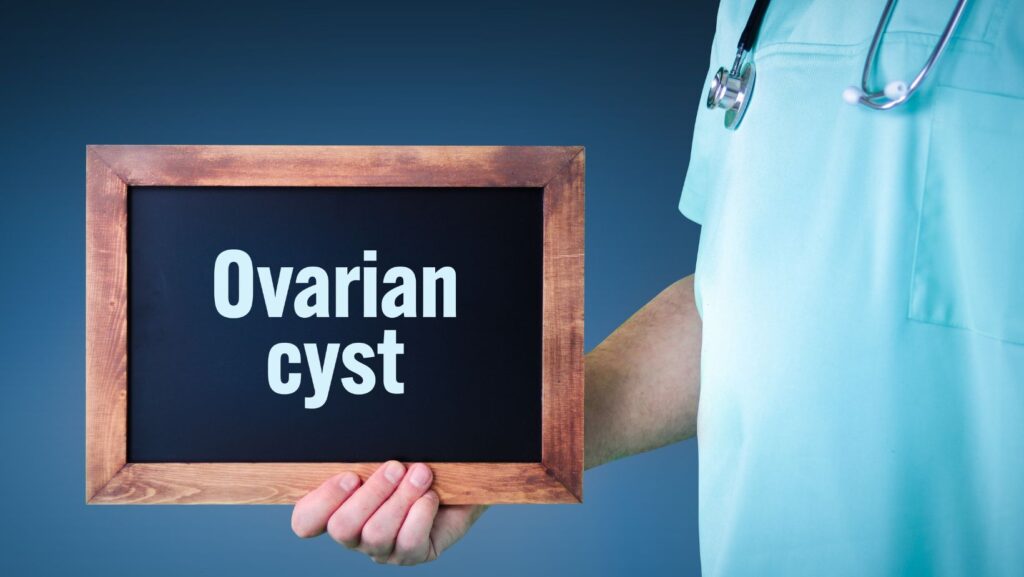
Ovarian cysts are common in women of reproductive age. These tiny sacs filled with liquid can develop for various reasons, often naturally occurring as part of the menstrual cycle. Most ovarian cysts are benign and heal without intervention; however, certain types, particularly complex ovarian cysts, may pose more serious health risks.
Understanding the causes and symptoms of ovarian cysts, along with their potential risks, is essential for timely diagnosis and treatment. Continue reading this article for an in-depth discussion of complex ovarian cysts and their treatment.
What Are Complex Ovarian Cysts?
Ovarian cysts are classified into two main types: simple cysts and complex cysts. Simple ovarian cysts, like follicular cysts and corpus luteum cysts, are usually benign and form during a regular menstrual cycle. They’re often asymptomatic and may go unnoticed, resolving naturally without treatment.
On the other hand, complex ovarian cysts contain both solid and fluid-filled areas. These cystic structures can arise from hormonal imbalances, endometriosis, or even tumors. Complex ovarian cysts are more likely to cause symptoms such as severe pelvic pain, lower abdominal pain, and irregularities in the menstrual cycle.
Routine pelvic exams are essential for identifying ovarian cysts early, especially in asymptomatic women or those experiencing mild discomfort. For a thorough assessment, international ovarian tumor analysis is often used to evaluate adnexal masses and determine the likelihood of malignancy.
Treatment for Complex Ovarian Cysts
Treatment for ovarian cysts varies depending on their size, symptoms, and potential risks, including the possibility of malignancy. Below are the standard treatment options:
Hormonal Therapy
Hormonal medications, including contraceptive pills, can assist in regulating the menstrual cycle and reducing the likelihood of forming new cysts. Hormonal therapy is often used as a treatment for ovarian cyst for women with recurrent conditions as it helps manage underlying hormonal imbalances that contribute to their development.
Watchful Waiting
Healthcare providers may recommend a “watch and wait” approach for a smaller and asymptomatic cyst. This involves regular monitoring with ultrasounds and pelvic exams to observe changes in size or characteristics over time. If the condition remains stable or resolves naturally, no further treatment is needed.
Pain Management
For women suffering from mild to moderate discomfort, consider over-the-counter analgesics such as ibuprofen or acetaminophen. If the pain persists or worsens, stronger medications may be prescribed. Pain management is typically a complementary treatment to other interventions.
Surgical Removal
Surgery may be required for complex ovarian cysts that are large, persistent, or causing severe symptoms. Two standard surgical methods include laparoscopy and laparotomy. Laparoscopy involves making small incisions to facilitate the removal of a cyst with the assistance of a camera-guided instrument. This approach is often used for smaller cysts.
Meanwhile, a laparotomy is a more invasive surgery used for larger or suspicious cysts. This process facilitates a comprehensive analysis of the cyst and adjacent tissues, especially in cases where there is a suspicion of malignancy.
Treatment for Ruptured Cysts
In the event of a rupture of a complex ovarian cyst, it may lead to acute and intense abdominal pain. There may also be internal bleeding or infection. Emergency treatment typically includes hospitalization, fluid replacement, and sometimes surgery to control bleeding and remove the cyst.
Management of Cancerous Cysts
If the cyst is determined to be malignant, the treatment may combine surgical intervention, chemotherapy, or radiation therapy. The surgical procedure could include removing the affected ovary or both ovaries and, in some cases, other surrounding tissues. Post-surgical treatments aim to eliminate any remaining cancer cells.
Fertility Preservation Treatments
For women in their childbearing years, preserving fertility is a critical consideration. When surgery is necessary, healthcare providers often prioritize procedures that remove the cyst while leaving the healthy ovary intact. Hormonal treatments may also be tailored to support fertility goals.
Each treatment plan is customized based on factors like the woman’s age, overall health, reproductive goals, and the cyst’s characteristics. The most effective strategy for patients is to receive guidance from a healthcare professional in managing intricate ovarian cysts and mitigating possible complications.
Are Complex Ovarian Cysts Cancerous?
Most ovarian cysts are non-cancerous; however, certain complex ovarian cysts may cause concern because of their composition and associated symptoms. The risk of malignancy is typically higher in older women, postmenopausal individuals, and those with a family history of ovarian cancer. Complex cysts with solid areas, irregular shapes, or rapid growth can be indicative of underlying ovarian cancer, though most cysts turn out to be non-cancerous after thorough evaluation.
When to Seek Medical Attention
Timely medical intervention is essential for the effective management of ovarian cysts, particularly those that are highly complex. If you’re dealing with intense pelvic pain, lower belly aches, or unusual menstrual patterns, it’s imperative to reach out to a healthcare professional. These symptoms may indicate the presence of a giant or potentially problematic cyst that requires further investigation.
Conclusion
Complex ovarian cysts are less common than simple cysts but can cause significant symptoms or health concerns if left untreated. Whether you’re experiencing pain or learning about ovarian cysts during a routine pelvic exam, understanding your options is critical. With timely intervention and appropriate care, most women can achieve a positive outcome.














